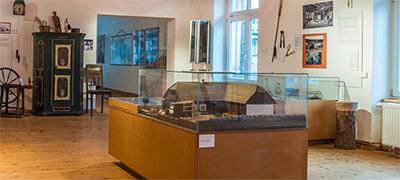Muzeum Kvilda
The legacy of the underpaintings on glass
At the end of 2020, the project Link of the underpaintings on glass was completed. The project was implemented by the Municipality of Kvilda and the Municipality of Hohenau as part of the Czech-Bavarian cross-border cooperation. It contributes significantly to the preservation of the Czech-Bavarian cultural heritage.
"The art of glass painting originated in the early 18th century in the municipalities of Hohenau - Schönbrunn am Lusen and Raimundsreut," says the mayor of Kvilda, Václav Vostradovský, by way of introduction.
"Around 1800, it spread to Bohemia. At the beginning of the 19th century, Johann Verderber founded a glass underpainting factory in Kvilda," continues Václav Vostradovský.
The paintings were then sold by peddlers (known in Bavaria as 'Kraner') who moved along the historic routes and offered their goods throughout the Bavarian-Czech border region. At the end of the 19th century the decline of underpainting on glass began and the advent of colour printing brought this era to an end.
Thanks to a joint concept, museums have been created in the two villages to show visitors the history of glass underpainting and the importance of glass in the history of the region's settlement. The building of the Kvilda museum was built right in the centre of the village. On the ground floor there are arts and crafts workshops and an education room.
"In the workshop, visitors can make their own "folk" underpainting on glass. On the first floor there is a permanent exhibition on 100 m2," continues the mayor of Kvilda, Václav Vostradovský.
The exhibition of Kvilda underpainting focuses on the presentation of the products of art and craft workshops in Kvilda and the surrounding area. It consists of original exhibits, replicas, paneling with interactive elements and presentations.
Both museums are located in close proximity to historical sites such as the former glassworks, the pilgrimage site of St. Anna in Kreuzberg, which was a frequent motif for glass paintings, and the Golden Trail as a direct trade link between Kvilda and Hohenau. You can buy a joint ticket to both museums.
"The good news for cyclists in particular is the creation of a cycle path that runs parallel to the Golden Trail - between Hohenau, Mauth and Kvilda - and allows tourists to visit both museums in one day. The QR codes along the way will provide information about the underpainting on glass and the history of trade between Bohemia and Bavaria," says Václav Vostradovský in conclusion.
The total cost of the project is estimated at CZK 30 million. The cost of the project is estimated at CZK 30 million. The project was 85% co-funded by the Cross-border Cooperation Programme Czech Republic - Free State of Bavaria Objective ECA 2014-2020, 5% of the Czech part from the budget of the Ministry of Regional Development of the Czech Republic and the remaining 10% in the Czech Republic and 15% in Bavaria were co-funded by the municipalities.

Kvilda
Apart from Kvilda, where everybody has the right to divide the year into spring, summer, autumn and winter, in a landscape where it is cold for three months and cold for nine months, the village of Kvilda is situated on the open plateau of Šumava, on a mountain stream and around a wooden church, the place where the pictures are made that adorn the quilts of almost all the peasant worlds in the poor mountain regions of our vast home, from Bohemia down to the coast, washed by the blue waters of the sea.
Josef Messner, Pictures from Šumava, Budějovický okresní list, 4 March 1863
The museum building is located in the centre of the village of Kvilda and is connected to the municipal office building.







